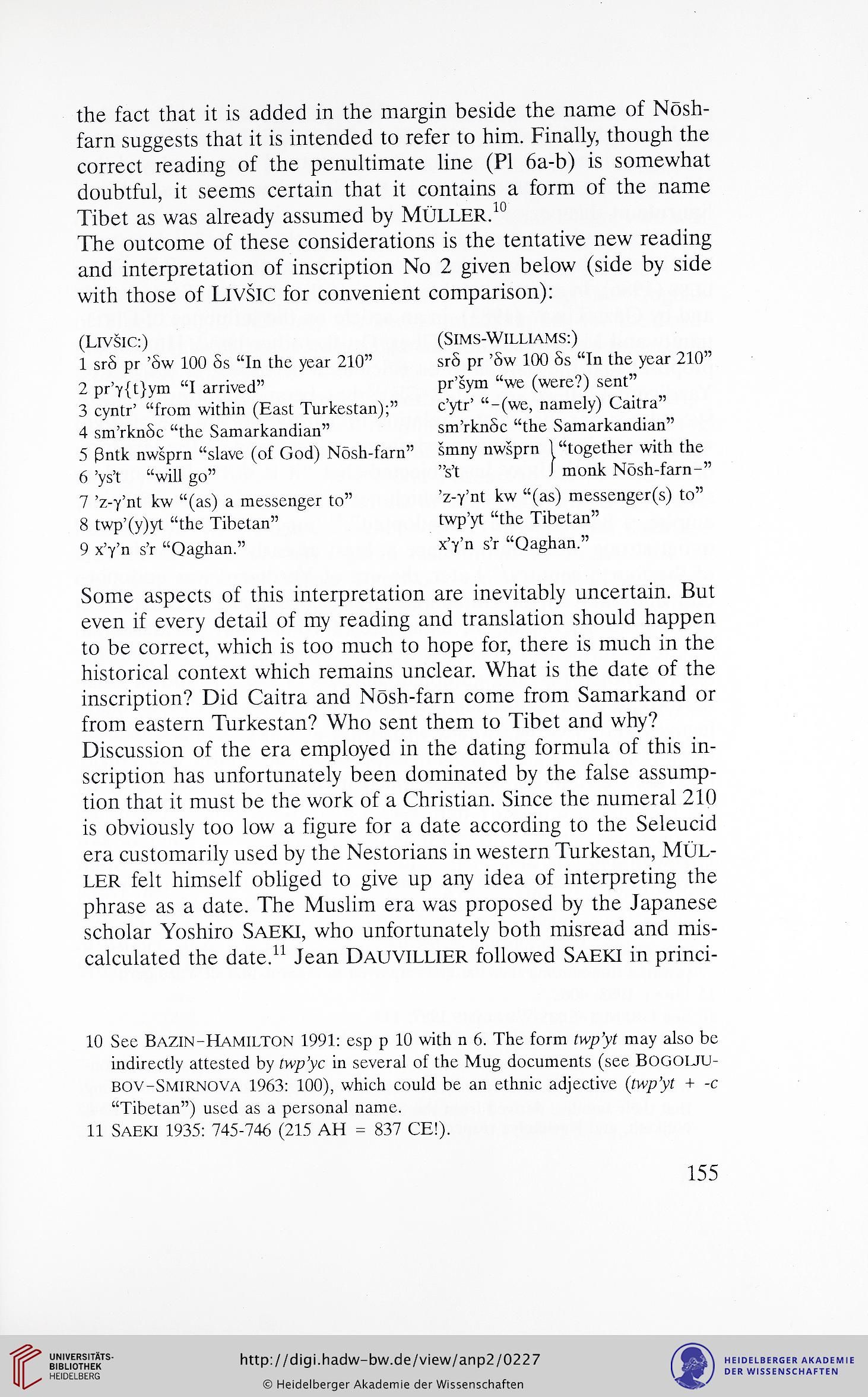the fact that it is added in the margin beside the name of Nôsh-
farn suggests that it is intended to refer to him. Finally, though the
correct reading of the penultimate line (PI 6a-b) is somewhat
doubtful, it seems certain that it contains a form of the name
Tibet as was already assumed by MÜLLERÜ'
The outcome of these considerations is the tentative new reading
and interpretation of inscription No 2 given below (side by side
with those of LlVSlC for convenient comparison):
(Livsic:)
1 srô pr '5w 100 5s "In the year 210"
2 pr'y{t}ym "I arrived"
3 cyntr' "from within (East Turkestan);"
4 sm'rknSc "the Samarkandian"
5 ßntk nwsprn "siave (of God) Nösh-farn"
6 'ys't "wifi go"
7 'z-y'nt kw "(as) a messenger to"
8 twp'(y)yt "the Tibetan"
9 x'y'n s'r "Qaghan."
(SIMS-WILLIAMS:)
srô pr '5w 100 5s "In the year 210'
pr'sym "we (were?) sent"
c'ytr' "-(we, namely) Caitra"
sm'rknôc "the Samarkandian"
smny nwsprn ("together with the
"s't i monk Nösh-farn-'
'z-y'nt kw "(as) messenger(s) to"
twp'yt "the Tibetan"
x'y'n s'r "Qaghan."
Some aspects of this interpretation are inevitably uncertain. But
even if every detail of my reading and translation should happen
to be correct, which is too much to hope for, there is much in the
historical context which remains unclear. What is the date of the
inscription? Did Caitra and Nösh-farn come from Samarkand or
from eastern Turkestan? Who sent them to Tibet and why?
Discussion of the era employed in the dating formula of this in-
scription has unfortunately been dominated by the false assump-
tion that it must be the work of a Christian. Since the numeral 210
is obviously too low a figure for a date according to the Seleucid
era customarily used by the Nestorians in western Turkestan, MÜL-
LER felt himself obliged to give up any idea of interpreting the
phrase as a date. The Muslim era was proposed by the Japanese
scholar Yoshiro SAEKI, who unfortunately both misread and mis-
calculated the date.^ Jean DAUVILLIER followed SAEKI in princi-
10 See BAZIN-HAMILTON 1991: esp p 10 with n 6. The form Pypjyt may also be
indirectly attested by in several of the Mug documents (see BOGOLJU-
BOV-SMIRNOVA 1963: 100), which could be an ethnic adjective (twpyt + -c
"Tibetan") used as a personal name.
11 SAEKt 1935: 745-746 (215 AH = 837 CE!).
155
farn suggests that it is intended to refer to him. Finally, though the
correct reading of the penultimate line (PI 6a-b) is somewhat
doubtful, it seems certain that it contains a form of the name
Tibet as was already assumed by MÜLLERÜ'
The outcome of these considerations is the tentative new reading
and interpretation of inscription No 2 given below (side by side
with those of LlVSlC for convenient comparison):
(Livsic:)
1 srô pr '5w 100 5s "In the year 210"
2 pr'y{t}ym "I arrived"
3 cyntr' "from within (East Turkestan);"
4 sm'rknSc "the Samarkandian"
5 ßntk nwsprn "siave (of God) Nösh-farn"
6 'ys't "wifi go"
7 'z-y'nt kw "(as) a messenger to"
8 twp'(y)yt "the Tibetan"
9 x'y'n s'r "Qaghan."
(SIMS-WILLIAMS:)
srô pr '5w 100 5s "In the year 210'
pr'sym "we (were?) sent"
c'ytr' "-(we, namely) Caitra"
sm'rknôc "the Samarkandian"
smny nwsprn ("together with the
"s't i monk Nösh-farn-'
'z-y'nt kw "(as) messenger(s) to"
twp'yt "the Tibetan"
x'y'n s'r "Qaghan."
Some aspects of this interpretation are inevitably uncertain. But
even if every detail of my reading and translation should happen
to be correct, which is too much to hope for, there is much in the
historical context which remains unclear. What is the date of the
inscription? Did Caitra and Nösh-farn come from Samarkand or
from eastern Turkestan? Who sent them to Tibet and why?
Discussion of the era employed in the dating formula of this in-
scription has unfortunately been dominated by the false assump-
tion that it must be the work of a Christian. Since the numeral 210
is obviously too low a figure for a date according to the Seleucid
era customarily used by the Nestorians in western Turkestan, MÜL-
LER felt himself obliged to give up any idea of interpreting the
phrase as a date. The Muslim era was proposed by the Japanese
scholar Yoshiro SAEKI, who unfortunately both misread and mis-
calculated the date.^ Jean DAUVILLIER followed SAEKI in princi-
10 See BAZIN-HAMILTON 1991: esp p 10 with n 6. The form Pypjyt may also be
indirectly attested by in several of the Mug documents (see BOGOLJU-
BOV-SMIRNOVA 1963: 100), which could be an ethnic adjective (twpyt + -c
"Tibetan") used as a personal name.
11 SAEKt 1935: 745-746 (215 AH = 837 CE!).
155




